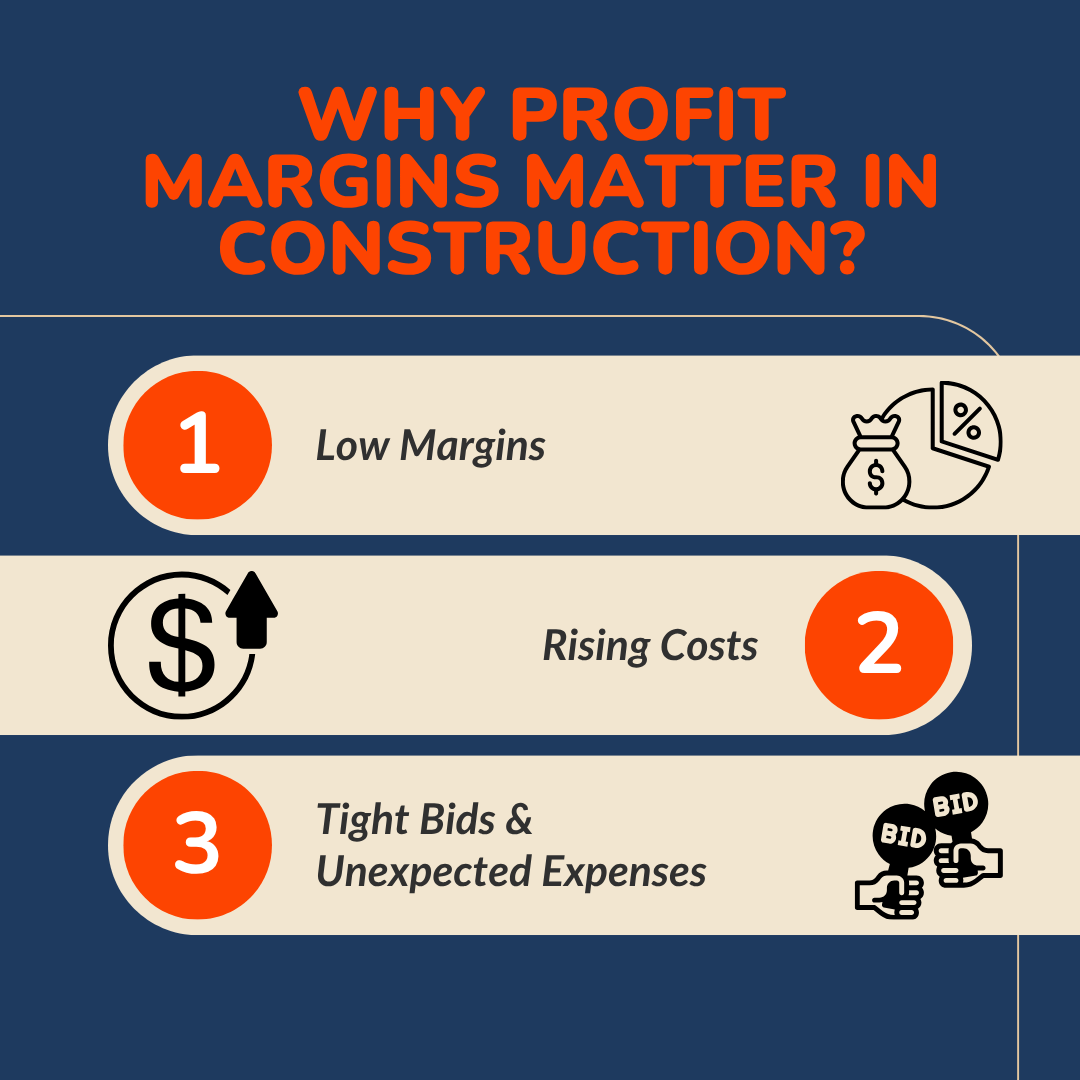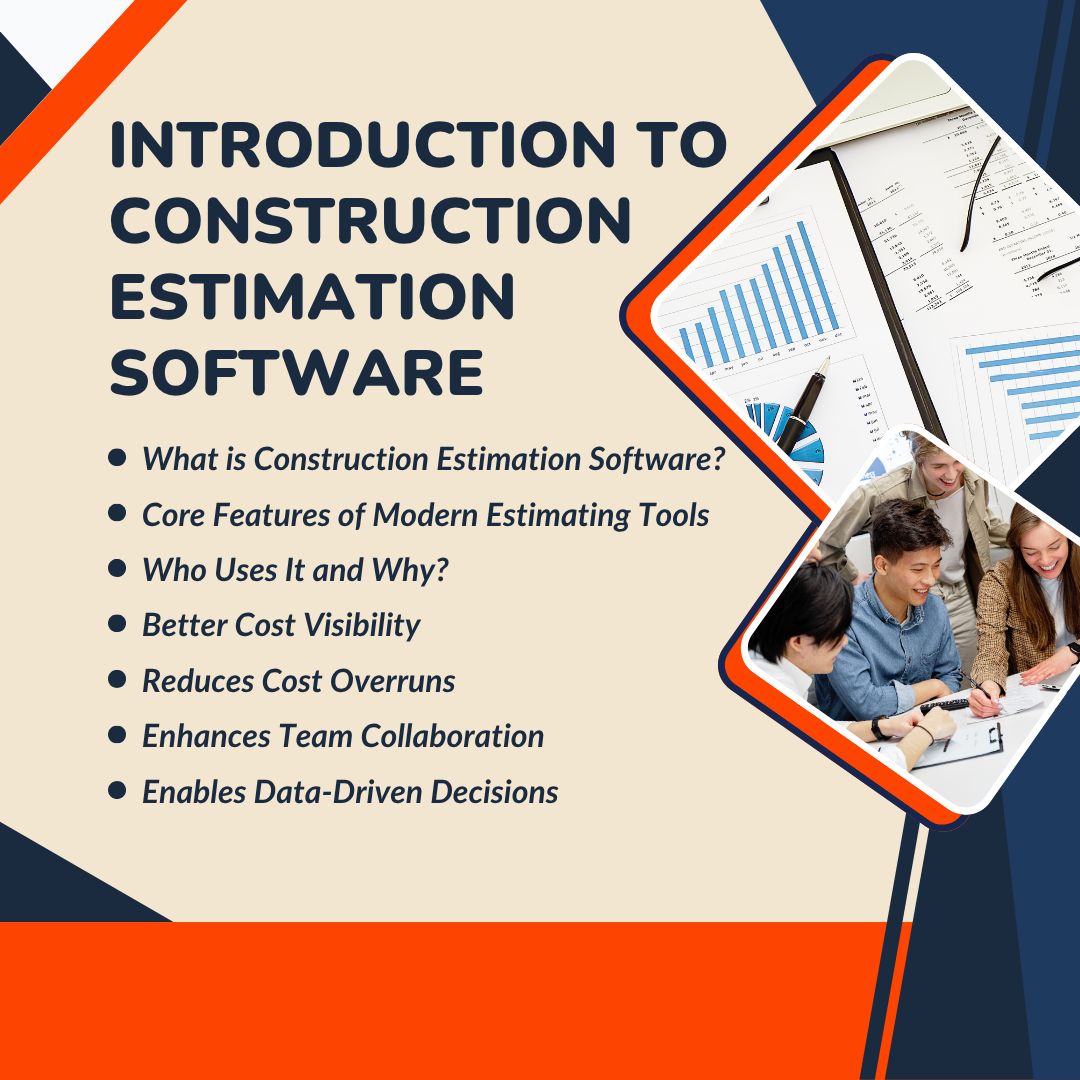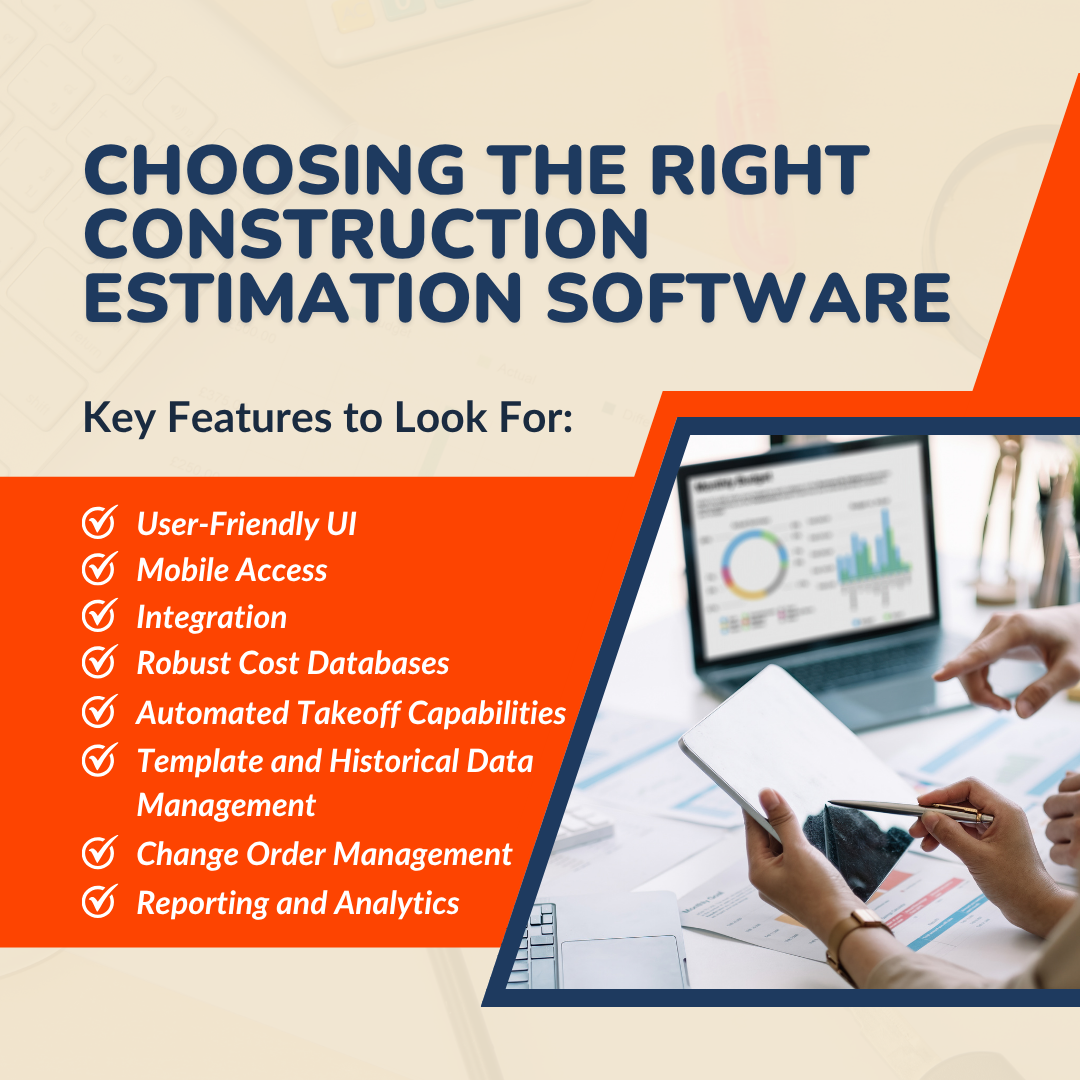Let’s face it: construction involves more than just concrete and steel today. It’s all about the numbers, and even a tiny miscalculation can cut into your profits.
In an industry with narrow profit margins, a single error in a bid or a missed material update can determine whether one breaks even or faces substantial losses.
That’s where construction estimation software proves invaluable, not merely an extra, but an essential resource for staying afloat. It enables contractors and project managers to create quick, accurate estimates, integrate real-time material costs, and avoid incurring costly last-minute expenses.
How does it affect your profitability? And is the investment truly justified? Let's see how accurate estimation leads to greater profits and emphasizes the importance of getting your figures correct from the beginning.
Key Takeaways
- Understanding Profit Margins: Definitions, calculations, and significance in construction.
- Challenges in Managing Profit Margins: Common pitfalls construction companies face in estimating and managing costs.
- How Estimation Software Helps: How modern tools automate and streamline estimating, improving accuracy and efficiency in cost management. We’ll also provide actionable insights and examples demonstrating the impact of estimation software on profit margins.
Why Profit Margins Matter in Construction?

Profit margins are crucial indicators of financial health in the construction industry. However, maintaining healthy margins is challenging due to several factors.
- Low Margins: The industry has some of the slimmest profit margins. High competition, fluctuating material costs, and lengthy project timelines contribute to this reality, as even minor cost increases or delays can quickly erode profits.
- Rising Costs: Material, labor, fuel, and compliance costs have steadily increased, dramatically reducing profit margins for construction companies and heightening the importance of cost management.
- Tight Bids and Unexpected Expenses: Many companies bid low to win contracts, leaving little room for unforeseen costs. Unexpected issues, such as delays, change orders, or price hikes, further pressure already tight profit margins.
Who Should Read This?
This guide is for:
- Contractors: Whether running a large firm or freelancing, improving profit margins is crucial for competitiveness.
- Project Managers: Those overseeing the financial aspects of projects can prevent cost overruns by making more accurate estimates.
- Young Construction Entrepreneurs: If you're new to the industry or launching a company, effective cost management is essential for success and profitability from the outset.
By reading this guide, these professionals will gain an understanding of the tools to address profit margin issues and enhance the financial health of their projects.
Definition of Profit Margin (Gross vs. Net)
In construction, we primarily talk about two key types of profit margins:
> Gross Profit Margin:
This is the revenue generated from a project minus the direct costs associated with completing that specific project. Direct costs typically include materials, labor directly involved in construction, and equipment rentals for the project.
The formula is:
Gross Profit Margin = (Total Revenue−Cost of Goods Sold) / Total Revenue ×100
> Net Profit Margin:
This provides a more comprehensive picture of your company's profitability. It's calculated by subtracting all other operating expenses, including overhead, from the gross profit.
Overhead costs encompass expenses not tied to a specific project, such as office rent, administrative salaries, utilities, insurance, and the costs associated with estimating and sales.
The formula is:
Net Profit Margin = (Total Revenue - Total Expenses) / Total Revenue * 100.
While a healthy gross profit margin is essential, the net profit margin is the true indicator of your business's overall financial success.
> Statistical Highlight:
Profit margins are crucial for the sustainability of construction companies. However, actual net profit margins in the industry are relatively low, typically averaging between 2% and 15% of total revenue.
These narrow margins imply that every dollar you save or lose can significantly affect your bottom line.
Key Factors That Affect Margins

Many factors can affect a construction project's profitability, including:
- Material Costs: Fluctuations in the prices of raw materials, such as lumber, steel, concrete, and fuel, can significantly impact project costs and erode margins if not accurately predicted and managed.
- Labor: The cost of skilled and unskilled labor, including wages, benefits, and availability, is a major factor. Labor shortages or inefficiencies can lead to increased costs and project delays.
- Time Overruns: Delays in the project schedule, caused by factors such as weather, unforeseen site conditions, or logistical issues, result in increased labor costs, extended equipment rental periods, and potential penalty clauses.
- Change Orders: While sometimes a source of additional revenue, poorly managed or undocumented change orders can lead to delays and disputes, negatively impacting profitability.
- Subcontractor Management: The performance and costs associated with subcontractors directly affect project margins. Poor subcontractor selection or inadequate oversight can lead to quality issues, delays, and cost overruns.
- Equipment Costs: The cost of purchasing, maintaining, and renting equipment is a significant expense that must be accurately estimated and tracked.
- Overhead Allocation: Properly allocating overhead costs across projects is essential for accurately understanding the true profitability of each project. Inaccurate allocation can result in underpricing or overpricing of bids.
- Project Management Efficiency: Effective planning, scheduling, and on-site management are critical to keeping projects on track and within budget. Inefficiencies can quickly lead to cost overruns.
The Profit Margin Problem: Why It’s Hard to Stay Profitable?

Given the numerous factors at play, maintaining consistent profitability in construction is a significant challenge. Several common problems plague the industry, often stemming from outdated processes and a lack of real-time visibility.
1. Inaccurate Bids
One of the most significant threats to profit margins is submitting inaccurate bids. This can happen for several reasons:
- Underestimating Costs: Missing line items, using outdated material or labor rates, or miscalculating quantities can lead to bids that are too low to cover actual project costs, resulting in losses.
- Overestimating Costs: While seemingly safer, overestimating can lead to losing bids to more competitively priced contractors, resulting in reduced work volume and overall revenue.
- Lack of Historical Data: Without access to accurate construction cost estimating data from past projects, estimators often rely on guesswork, which increases the likelihood of inaccuracies.
2. Poor Cost Forecasting
Even with an accurate initial bid, poor cost forecasting throughout the project lifecycle can smash margins. This involves failing to anticipate and track costs as they are incurred, leading to:
- Budget Overruns: Failing to identify cost variances early on makes it difficult to take corrective action before they significantly impact profitability.
- Inaccurate Cash Flow Projections: Poor forecasting can lead to unexpected cash shortfalls, potentially impacting the ability to pay for materials or labor and causing delays.
3. Mismanaged Resources
Inefficiently managing resources – labor, materials, and equipment – directly impacts costs and profitability. This can manifest as:
- Material Waste: Ordering excessive material or improper on-site handling leads to unnecessary expenses.
- Labor Inefficiency: Poor scheduling, unclear tasks, or insufficient supervision can result in wasted labor hours.
- Equipment Downtime: Equipment breakdowns or the lack of necessary equipment can cause costly delays.
4. Manual Errors in Estimation
Despite the best efforts, manual estimation processes using spreadsheets or even paper can be highly susceptible to human error:
- Calculation Mistakes: Simple arithmetic errors can significantly impact an entire bid.
- Data Entry Errors: Incorrectly entering material quantities or labor hours can lead to significant discrepancies.
- Using Outdated Information: Manually tracking fluctuating material prices and labor rates is challenging and can result in the use of outdated, inaccurate data.
5. Scope Creep and Change Orders
Uncontrolled scope creep and poorly managed change orders are notorious for eroding profit margins.
- Undocumented Changes: Performing additional work without a formal change order means you won't get paid for the extra time and materials.
- Lack of Impact Analysis: Failing to fully assess the cost and schedule impact of a change order before approval can result in unforeseen expenses and delays.
- Delayed Approval: Slow approval processes for change orders can hold up work and impact the project timeline.
This is where modern construction estimation software, and specifically Constructionbase, comes into play, offering powerful solutions to these pervasive problems and directly impacting your bottom line.
Introduction to Construction Estimating Software

In an industry with thin margins and challenges, technology is essential. The construction estimating process has transformed how businesses approach bidding and project planning, enhancing profitability.
1. What is Construction Estimation Software?
Construction estimation software streamlines and automates the calculation of a construction project's anticipated costs.
Moving beyond manual methods, it offers a structured, data-driven approach to create accurate bids, gathering and analyzing cost components from takeoff to proposal. The goal is to provide a reliable financial blueprint, minimizing guesswork and costly errors.
2. Core Features of Modern Estimating Tools
Modern construction estimation software has features that improve accuracy, efficiency, and collaboration. Key features include:
- Quantity Takeoff: This feature enables users to measure and quantify materials and labor from digital blueprints quickly. The software automates measurements, reducing errors and saving time.
- Cost Databases: Robust databases contain current pricing information for materials, labor rates, and equipment costs. Many solutions allow for customization with a company's historical cost data.
- Templates and Historical Data: Estimation software often provides customizable templates for different projects, pre-filled with common cost categories. Accessing historical data from past projects offers benchmarks for informed decision-making.
- Integration with Project Management and Accounting: Seamless integration with management tools ensures a consistent data flow throughout the project lifecycle, reducing duplicate data entry, minimizing errors, and providing a comprehensive view of performance.
3. Who Uses It and Why?
Various construction professionals rely on construction estimation software:
- Contractors and Builders: They create bids, manage project costs, and track profitability. The software ensures competitive and profitable bids.
- Estimators: Primary users develop accurate cost estimates, performing efficient takeoffs and generating proposals using the software.
- Architects and Designers: They can use estimation tools for preliminary cost estimates during design, helping clients understand potential costs and stay within budget.
- Subcontractors: Many prepare bids for specific work portions, providing accurate quotes to general contractors. Submit more proposals. A higher volume of accurate, competitive bids directly translates to more opportunities to win profitable projects and increase your overall revenue.
4. Better Cost Visibility
Maintaining profitability requires real-time insight into project costs.
Real-Time Updates on Costs: Modern software integrates with regularly updated cost databases, providing current market prices for materials, labor, and equipment. This visibility, a key feature of Constructionbase, ensures estimates are based on the latest information, reducing unexpected cost increases during the project.
5. Reduces Cost Overruns
Cost overruns threaten construction profitability. Estimation software mitigates this risk through improved planning and tracking.
Forecasting Tools for Inflation and Delays: Advanced software often includes features for sophisticated cost forecasting and analysis. You can account for material price inflation and incorporate contingencies for delays and risks.
By planning within the software, you manage costs effectively and avoid unexpected overruns that impact profit margins.
6. Enhances Team Collaboration
Miscommunication between the office and the adoption of new software can seem daunting. Still, smooth integration is key to quickly realizing the benefits of construction estimation software and maximizing profit margins.
A. Onboarding Your Team:
Successful adoption starts with your team. Provide sufficient training and support to ensure everyone using the software understands its functions and their daily tasks.
B. Migrating Data from Spreadsheets:
Transitioning from spreadsheets requires a data migration plan. This may involve exporting existing cost databases, material lists, and historical project data into a format compatible with the new software.
C. Training for Non-Tech-Savvy Users
Not all team members may be comfortable with technology. Select software with a user-friendly interface and invest in tailored training for individuals who require additional support.
D. Centralized Data = Less Miscommunication
Cloud-based estimation software centralizes all project data, making it accessible to relevant team members in real time.
7. Enables Data-Driven Decisions
Leveraging historical project data is the first step to improvement and profitability.
Estimation software stores data from completed projects, allowing analysis of trends and the effectiveness of previous estimates.
Platforms like Constructionbase help access this data, refine templates, and make informed decisions for more accurate bids and improved profitability.
Discover how Construction Estimation Software helps you generate precise bids in just minutes.
Choosing the Right Construction Estimation Software

Selecting the right construction estimation software is a crucial decision that can significantly impact your business's efficiency and profitability. Here's what to consider:
Key Features to Look For:
Not all estimation software is created equal. Look for a solution that offers the features essential to your business needs:
- User-Friendly UI: The software should be intuitive and easy to navigate, even for team members who may not be highly technical. A complex interface can hinder adoption and reduce efficiency.
- Mobile Access: In the construction industry, being able to access and update information from the field is vital. Look for cloud-based software with mobile compatibility, allowing your team to stay connected on the go.
- Integration: Ensure the software integrates seamlessly with your existing project management, accounting, and CRM tools to create a unified workflow and avoid double data entry.
- Robust Cost Databases: Access to regularly updated and customizable cost databases is fundamental for accurate estimating.
- Automated Takeoff Capabilities: Digital takeoff tools that allow you to measure directly on plans are a significant time-saver and accuracy booster.
- Template and Historical Data Management: The ability to use and customize templates, as well as leverage past project data, is crucial for efficiency and continuous improvement.
- Change Order Management: Look for features that streamline the process of creating, tracking, and getting approval for change orders.
- Reporting and Analytics: The software should provide insightful reports and analytics on your bids, project costs, and profitability.
Take a look at the Top Construction Management Software in 2025
What to Avoid?
Be mindful of potential pitfalls when evaluating estimation software:
- Overcomplicated Tools: Don't be swayed by an abundance of complex features you don't need. Choose software that is both powerful and user-friendly for your team.
- Lack of Customer Support: Implementing new software often raises questions. Ensure the vendor offers reliable and accessible customer support and training resources.
- Hidden Costs: Thoroughly understand the pricing structure to avoid unexpected expenses. Be aware of any hidden fees for implementation, training, support, or additional features.
- Poor Integration Capabilities: Software that fails to integrate seamlessly with your existing systems can create data silos and inefficiencies.
- Outdated Technology: Avoid software that is not regularly updated or built on outdated technology, as it may lack essential features and security.
Top Construction Estimation Tools in 2025
The market offers a variety of construction estimation software solutions, each with its strengths. Here's a brief look at a few:
| Software Name | Key Strengths | Best For |
|---|---|---|
| Constructionbase | Automated takeoffs, real-time collaboration, integrated cost databases, user-friendly interface, strong focus on accuracy and efficiency to improve profit margins. | Residential, Commercial, and Infrastructure contractors seeking a modern, comprehensive, and easy-to-use solution. |
| ProEst | Robust features for larger contractors, strong reporting, and analytics. | Mid-to-large commercial contractors. |
| STACK | Powerful takeoff features, cloud-based collaboration. | Contractors need detailed digital takeoffs. |
| Buildertrend | All-in-one construction management with integrated estimating. | Builders are looking for a comprehensive platform. |
Integrating Estimation Software Into Your Workflow

Adopting new software can seem daunting, but smooth integration is key to quickly realizing the benefits of construction estimation software and maximizing profit margins.
A. Onboarding Your Team
Successful adoption starts with your team. Provide sufficient training and support to ensure everyone using the software understands its functions and their daily tasks.
B. Migrating Data from Spreadsheets
Moving away from spreadsheets necessitates a well-planned data migration strategy. This may involve exporting existing cost databases, material lists, and historical project data into a format compatible with the new software.
C. Training for Non-Tech-Savvy Users
Not all team members may be comfortable with technology. Select software with a user-friendly interface and invest in tailored training for individuals who require additional support.
D. Common Mistakes to Avoid
When integrating estimation software, be mindful of these common pitfalls:
- Lack of Planning: Don't rush the implementation. Have a clear plan for data migration, training, and rollout.
- Insufficient Training: Inadequate training will lead to frustration and underutilization of the software's capabilities.
- Not Customizing the Software: Take the time to customize templates, cost codes, and databases to align with your company's specific workflows and needs.
- Ignoring Change Management: Simply providing the software isn't enough. Clearly communicate why the change is happening and how it will benefit both the team and the business.
- Failing to Leverage All Features: Explore and utilize the full range of features the software offers, such as reporting and analytics, to gain maximum value.
The Future of Estimation: AI, Automation, and More

Construction estimators are evolving, with advancements promising greater accuracy and efficiency.
A. Predictive Analytics in Estimation
Using historical data and machine learning, predictive analytics can more accurately identify risks and cost variances in projects. By analyzing past performance, the software offers insights into potential challenges, enabling robust estimates.
B. AI-Driven Suggestions for Material Choices or Vendors
AI analyzes cost databases and historical data to estimate cost-effective materials or reliable vendors based on past performance and pricing, optimizing estimates and procurement.
C. Cloud + Mobile for On-Site Estimating
Cloud and mobile technology enhances on-site data collection and preliminary estimation. This connectivity results in faster responses to changes and a dynamic estimation process.
Find out more about the Upcoming Trends in Construction Estimating Software Development.
Wrapping Up: Why Estimation Software is No Longer Optional
At the end of the day, profit margins in construction come down to one thing: knowing your numbers and managing them effectively. That’s exactly where construction estimation software excels.
It removes the uncertainty of bidding, prevents expensive surprises, and ensures your projects remain financially on track.
Regardless of whether you’re a small contractor or overseeing large-scale developments, the appropriate tool can be the key to transitioning from breaking even to securing a solid profit. Ready to upgrade!
More about Constructionbase
Ready to win more projects? Begin estimating more efficiently with Constructionbase today!
Let’s build a better future together. Join us today!
Frequently Asked Questions
1. How can I increase my construction company’s profitability?
Improve profitability by increasing bid accuracy, controlling indirect costs, enhancing project management, effectively managing change orders, and leveraging technology such as estimation software.
2. What’s the best software for construction cost estimation?
The best software depends on your needs, but look for accurate takeoffs, reliable cost data, and ease of use; Constructionbase is a strong option recognized for its automation and user-friendliness.
3. Is estimation software useful for small contractors?
Yes, absolutely. Estimation software saves small contractors time, improves bid accuracy to win more profitable jobs, and helps them better manage costs.
Have questions or need personalized advice?
Talk to an Expert Today and let our construction specialists guide you to success.







